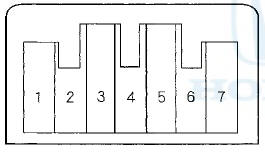 Honda Accord: Passenger's Air Mix Control Motor
Test
Honda Accord: Passenger's Air Mix Control Motor
Test
NOTE: Before testing the motor, check for HVAC DTCs (see page 21-101).
1. Disconnect the 7P connector from the passenger's air mix control motor.

Incorrectly applying power and ground to the passenger's air mix control motor will damage it.
Follow the instructions carefully.
2. Connect battery power to terminal No. 1 of the passenger's air mix control motor, and ground terminal No. 2; the passenger's air mix control motor should run, and stop at Max Cool. If it doesn't, reverse the connections; the passenger's air mix control motor should run, and stop at Max Hot. When the passenger's air mix control motor stops running, disconnect battery power immediately.
PASSENGER'S AIR MIX CONTROL MOTOR

3. If the passenger's air mix control motor did not run in step 2, remove it, then check the passenger's air mix control linkage and door for smooth movement.
• If the linkage and door move smoothly, replace the passenger's air mix control motor (see page 21-188).
• If the linkage or door sticks or binds, repair them as needed.
• If the passenger's air mix control motor runs smoothly, go to step 4.
4. Measure the resistance between terminals No. 5 and No. 7. It should be between 4.2 to 7.8 kQ.
5. Reconnect the passenger's air mix control motor 7P connector, then turn the ignition switch to ON (II).
6. Using the backprobe set, measure the voltage between terminals No. 3 and No. 5 of the 7P connector.
Max Cool: about 1.5 V
Max Hot: about 4.5 V
7. If either the resistance or the voltage readings are not as specified, replace the passenger's air mix control motor (see page 21 -188).
 Sunlight Sensor Replacement
Sunlight Sensor Replacement
1. Remove the sunlight sensor (A) from the dashboard,
then disconnect the connector (B). Be careful not to
damage the sensor and the dashboard.
2. Install the sensor in the reverse order of remov ...
 Passenger's Air Mix Control Motor
Replacement
Passenger's Air Mix Control Motor
Replacement
1. Remove the glove box (see page 20-174).
2, Disconnect the 4P connector (A) from the power
transistor (B), and the 7P connector (C) from the
passenger's air mix control motor (D). Remove the
s ...
See also:
Idler Gear/Idler Gear Shaft
Replacement
Special Tools Required
-Driver Handle, 15 x 135L 07749-0010000
-Attachment, 32 x 35 mm 07746-0010100
1. Remove the snap ring from the idler gear/idler shaft
assembly. Do not distort the snap ring. ...
Lower Arm A Replacement
1. Raise and support the vehicle (see page 1-13).
2. Remove the rear wheel.
3. Remove the parking brake cable mounting bolt (B).
4. Remove the lower arm A mounting bolts, then
remove lower a ...
Towing Your Vehicle
Your vehicle is not designed to be
towed behind a motor home. If your
vehicle needs to be towed in an
emergency. ...
